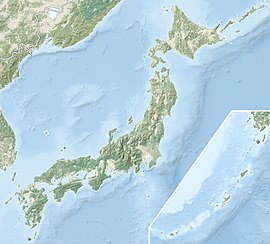The Kajikurihama Site (梶栗浜遺跡, Kajikurihama iseki) is an archaeological site with a Yayoi period cemetery located in the Kajikuricho neighborhood of the city of Shimonoseki, Yamaguchi Prefecture, in the San'yō region of Japan. It was designated a National Historic Site in 1980.[1]
梶栗浜遺跡 | |
| Location | Shimonoseki, Yamaguchi, Japan |
|---|---|
| Region | San'yō region |
| Coordinates | 34°01′00″N 130°55′23″E / 34.01667°N 130.92306°E |
| Type | cemetery trace |
| History | |
| Periods | Yayoi period |
| Site notes | |
| Public access | Yes (no facilities) |
 | |
Overview
editThe Kajikurihama site is located 500 meters from the present-day coast of Hibiki Bay, extending north–south at an elevation of 3.5 meters. It was discovered in 1913, during the construction of the Chōshū Railway (now the San'in Main Line) when a box-type sarcophagus was unearthed. In subsequent archaeological excavations in 1932 and 1935, narrow bronze swords, possibly imported from the Korean Peninsula were discovered, along with additional graves, and in 1957 Yayoi pottery dating the site to the mid-Yayoi period was found. Other grave goods included a multi-pronged bronze mirror and a ceremonial bronze sword. The cemetery is located approximately 400 meters to the north of the Ayaragigō Site, but the connection between the settlement and this cemetery is uncertain.[2]
The site is about an eight-minute walk from Kajikuri-Gōdaichi Station on the JR West Sanin Main Line.[2]
See also
editReferences
edit- ^ "梶栗浜遺跡" [Kajikurihama iseki] (in Japanese). Agency for Cultural Affairs. Retrieved August 31, 2022.
- ^ a b Isomura, Yukio; Sakai, Hideya (2012). (国指定史跡事典) National Historic Site Encyclopedia. 学生社. ISBN 4311750404.(in Japanese)

